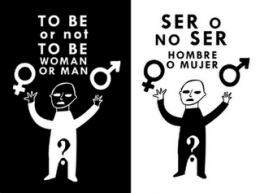Gender identity. Also known as generic identity is the way in which the person identifies, whether as a man or as a woman , the way in which they recognize themselves, basing their behavior and their way of being and thinking on that gender with which they feel identified, all this goes regardless of their sex, sexual orientation, age, socio-economic level, etc. It is the consciousness of the person to feel belonging to the male or female sex. A person may feel a gender identity other than their innate physiological characteristics.

Types
Among gender identities there are three types that are the most vulnerable:
Transvestite : It is a man or a woman who occasionally or in specific situations dresses and behaves like a person of the opposite gender (man as woman – woman as man).
Transgender : It is a man or woman who behaves and dresses permanently as a person of the opposite gender and it is already part of their lifestyle, however they are in agreement with their biological sex.
Transsexual : It is a man or woman who dresses and behaves permanently as a person of the opposite gender, this being part of their lifestyle, in addition to not agreeing with their biological sex, unlike the transgender person.
Gender identity disorder
A generic identity disorder exists when there is a conflict between a person’s actual physical sex and the sex with which he or she identifies. For example, a person sexually identified as male can actually feel and act like a female. The person experiences considerable discomfort with the biological sex with which they were born.
Causes, incidence, and risk factors
People with gender identity issues can act and present themselves as members of the opposite sex. The disorder can affect:
- The choice of sexual partners
- The display of feminine or masculine mannerisms, behavior and wardrobe
- The self-esteem
Gender identity disorder is not the same as homosexuality .
Identity conflicts can occur in many situations and manifest themselves in different ways. For example, some people with genitalia and normal sexual characteristics of one sex (such as breasts) privately identify more with the other sex.
Some people may dress the other way around and others may seek surgery to change their sex. Others are born with ambiguous genitalia, which can raise concerns about their sex.
The cause is unknown, but hormones in the womb , genes, and environmental factors (such as childbearing) may play a role. This rare disorder can occur in children or adults.
Symptoms
Symptoms can vary by age and are affected by the person’s social environment. They may include the following:
- Children
- They have a dislike for their own genitalia
- They are rejected by their peers and feel isolated
- They believe that they will grow up and become of the opposite sex
- Suffer from depression or anxiety
- They say they wish to belong to the opposite sex
- Adults
- They dress as if they are of the opposite sex
- They feel isolated
- Suffer from depression or anxiety
- They wish to live as a person of the opposite sex
- They want to get rid of their own genitalia
- Adults or children
- They change the way they dress and show habits characteristic of the opposite sex
- They withdraw from social interaction
Complications
People with gender identity disorders can suffer from complications such as:
Depression or anxiety
Emotional distress
Feel isolated
They have low self-esteem
